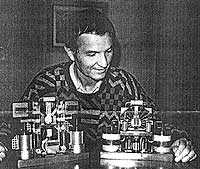For each of the two small testatika units and the 50cm disk unit there are two canisters, frequently refered to as pots. The contents of these pots are largely unkown. The only person reported to have seen inside was Stefan Marinov and he saw inside only the pots for one of the small units. He said the following:
|
The capacitors have a cylindrical "grid", cylindrical plastic insulation and a copper spiral in the center... THAT'S ALL! I saw in one of the small machines and there are no magnets. - Stefan Marinov 9/4/90 |
|
Further evidence of the presence of grids comes from the report from the visit of 30 engineers to the Methernitha community where near the bottom of the report, the following is said of the 50cm disk unit (the 3kW machine): "In the large capacitors there are 20 layers of perforated sheet (Baumann said)".
The idea behind these mark 4 pots was primarily to have cylindrical grid cylinders in the middle (i.e. the output ones, not the inner electrode or the outer electrode.) As well, I wanted more flexibility in what could be put in the pots without having to manufacture new ones from scratch all the time.
I wanted to try output grids which were much closer together. In the case below that is ones that were less than one hole/perforation diameter apart.
Construction of the Pots
|
|
| ||
|
|
| ||
|
|
|
|
|
Making grids from scratch
|
|
|
|
|


